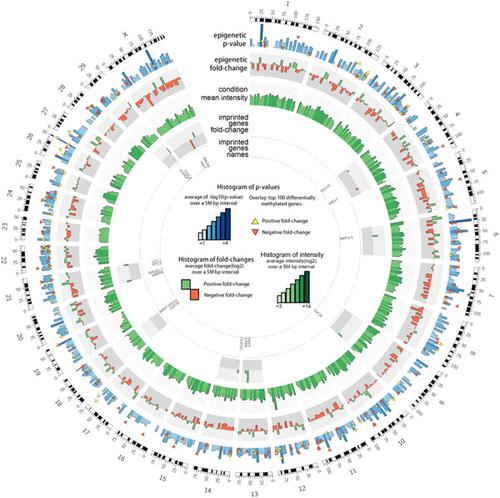当前位置:
X-MOL 学术
›
Mol. Reprod. Dev.
›
论文详情
Our official English website, www.x-mol.net, welcomes your
feedback! (Note: you will need to create a separate account there.)
DNA methylation status of bovine blastocysts obtained from peripubertal oocyte donors.
Molecular Reproduction and Development ( IF 2.7 ) Pub Date : 2020-07-17 , DOI: 10.1002/mrd.23399 Léonie Morin-Doré 1 , Patrick Blondin 2 , Christian Vigneault 2 , François-Xavier Grand 2 , Rémi Labrecque 2 , Marc-André Sirard 1
Molecular Reproduction and Development ( IF 2.7 ) Pub Date : 2020-07-17 , DOI: 10.1002/mrd.23399 Léonie Morin-Doré 1 , Patrick Blondin 2 , Christian Vigneault 2 , François-Xavier Grand 2 , Rémi Labrecque 2 , Marc-André Sirard 1
Affiliation

|
In the dairy industry, the high selection pressure combined with the increased efficiency of assisted reproduction technologies (ART) are leading toward the use of younger females for reproduction purposes, with the aim to reduce the interval between generations. This situation could impair embryo quality, decreasing the success rate of the ART procedures and the values of resulting offspring. Young Holstein heifers (n = 10) were subjected to ovarian stimulation and oocyte collection at 8, 11, and 14 months of age. All the oocytes were fertilized in vitro with semen from one adult bull, generating three pools of embryos per animal. Each animal was its own control for the evaluation of the effects of age. The EmbryoGENE platform was used to compare the DNA methylation status of blastocysts obtained from oocytes collected at 8 versus 14 and 11 versus 14 months of age. Age‐related contrast analysis identified 5,787 and 3,658 differentially methylated regions (DMRs) in blastocysts from heifers at 8 versus 14 and 11 versus 14 months of age, respectively. For both contrasts, the DMRs were distributed nonrandomly in the different DNA regions. The DNA from embryos from 8‐month‐old donors was more hypermethylated, while the DNA from embryos from 11‐month‐old donors displayed an intermediate phenotype. According to Ingenuity Pathway Analysis, the upstream regulator genes cellular tumor antigen p53, transforming growth factor β1, tumor necrosis factor, and hepatocyte nuclear factor 4α are particularly associated with methylation sensitive targets, which were more hypermethylated in embryos from younger donors.
中文翻译:

从青春期前卵母细胞供体获得的牛胚泡的DNA甲基化状态。
在乳制品行业中,高选择压力与辅助生殖技术(ART)效率的提高相结合,正导致将年轻女性用于生殖目的,目的是减少两代人之间的间隔。这种情况可能会损害胚胎质量,降低ART程序的成功率以及所产生的后代的价值。幼小荷斯坦母牛(n = 10)在8、11和14个月大时接受了卵巢刺激并收集了卵母细胞。所有的卵母细胞均用一头成年公牛的精液进行体外受精,每只动物产生三个胚胎库。每只动物都是其自己的对照,用于评估年龄的影响。EmbryoGENE平台用于比较从8个月,14个月,11个月和14个月大的卵母细胞获得的胚泡的DNA甲基化状态。年龄相关的对比分析确定了分别在8、14、11和14个月大的母牛的囊胚中的5,787和3,658个差异甲基化区域(DMR)。对于这两种对比,DMRs非随机分布在不同的DNA区域中。来自8个月大供体的胚胎的DNA甲基化程度更高,而来自11个月大供体的胚胎的DNA表现出中间表型。根据Ingenuity Pathway Analysis的研究,上游调节基因细胞肿瘤抗原p53,转化生长因子β1,肿瘤坏死因子和肝细胞核因子4α与甲基化敏感靶标特别相关,这些靶标在年轻供体的胚胎中甲基化程度更高。
更新日期:2020-08-28
中文翻译:

从青春期前卵母细胞供体获得的牛胚泡的DNA甲基化状态。
在乳制品行业中,高选择压力与辅助生殖技术(ART)效率的提高相结合,正导致将年轻女性用于生殖目的,目的是减少两代人之间的间隔。这种情况可能会损害胚胎质量,降低ART程序的成功率以及所产生的后代的价值。幼小荷斯坦母牛(n = 10)在8、11和14个月大时接受了卵巢刺激并收集了卵母细胞。所有的卵母细胞均用一头成年公牛的精液进行体外受精,每只动物产生三个胚胎库。每只动物都是其自己的对照,用于评估年龄的影响。EmbryoGENE平台用于比较从8个月,14个月,11个月和14个月大的卵母细胞获得的胚泡的DNA甲基化状态。年龄相关的对比分析确定了分别在8、14、11和14个月大的母牛的囊胚中的5,787和3,658个差异甲基化区域(DMR)。对于这两种对比,DMRs非随机分布在不同的DNA区域中。来自8个月大供体的胚胎的DNA甲基化程度更高,而来自11个月大供体的胚胎的DNA表现出中间表型。根据Ingenuity Pathway Analysis的研究,上游调节基因细胞肿瘤抗原p53,转化生长因子β1,肿瘤坏死因子和肝细胞核因子4α与甲基化敏感靶标特别相关,这些靶标在年轻供体的胚胎中甲基化程度更高。











































 京公网安备 11010802027423号
京公网安备 11010802027423号